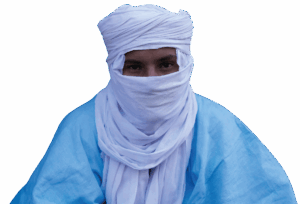Tuareg culture
Nomadic life with dromedaries
Without the dromedary, man would not have been able to occupy such hostile spaces as the nomads did.
High camel densities are found in Sahelian, semi-desert, and desert areas. Camel caravans are still characteristic of the Sahara today.
The Tuareg people are nicknamed the « lords of the desert » or the « blue men, » because the indigo-dyed cloth they sometimes use to protect themselves from the sand and sun rubs off on their skin.

The tagelmust is a Berber term referring to the head-covering veil or hood, while the word cheche originates from the city of Chah in Uzbekistan.
Dance holds an important place in Touareg culture. During festivities, such as the famous Sebiba celebration, the Touaregs dance with their dromedaries in a spectacle called the “camel dance” or Ilougan in Tamacheq.
This event highlights the deep bond between the Touareg people and their dromedaries.
Dromedaries among the Tuaregs
The dromedary is a prestigious animal among the Touaregs and is raised with particular care. It provides a wide range of services: a fast mount for travelers, a pack animal for caravan trade, and a dairy animal that supplies a significant portion of the owners’ diet.
While fulfilling these essential roles, its milk remains a staple of the nomadic diet. Its carrying capacity is not only used by Saharan caravans but also for short-distance transport around towns and southern markets.
In Niger, the Aïr Festival celebrates the richness of Touareg culture, including dromedary competitions. The festival features dance, singing, poetry contests, and of course, dromedary races, where the most beautiful and best-trained animals are rewarded.
Clothing adapted to the desert
The dark, loose clothing of the Tuaregs allows them to maintain a constant body temperature. It might seem counterproductive for people living in a scorching desert to wear dark colors, which absorb more heat than light colors. However, black garments also reflect more visible light and infrared radiation. A black fabric also produces more shade than a light fabric, retains less heat if it remains properly ventilated, and allows the warmer, lighter air to escape upward, thus cooling the fabric.
Adult men wear a veil that does not cover the eyes, while women generally do not cover their faces.
This “hood,” called a cheche or tagelmust, is particularly well-known in its indigo version, which is reserved for festivals and cold days because it retains heat, but all colors are accepted. White, for example, is a sign of respect or celebration.
Tuareg Society
This society is divided into several codified social classes that coexist with more or less equality. However, blacksmith artisans are excluded from marriage. There are also noble warriors who protect their vassals in exchange for a tribute, scholarly nobles (called maraboutic), vassal tribes, and descendants of slaves, who are sometimes still affected by this practice.
Organized into factions, these tribes are led by a chief and grouped under the authority of an elected amenokal or tamenokalt, such as Tin Hinan, whose power is symbolized by the war drum called the “ettebel.”

DID YOU KNOW ?
The riding saddle used by Tuareg camel herders, featuring a cross-shaped pommel, is placed in front of the hump, unlike the Moorish or Sudanese saddle (on the hump) and the Arabian saddle (behind the hump). The latter is used in races organized in the Emirates, although increasingly, robots are replacing young children who used to serve as jockeys—despite the opposition of many organizations denouncing these practices.
With the participation of :
